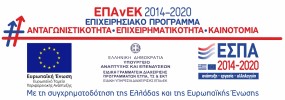
The project “MuseionTopos”, were GET participated, project code: Τ1ΕΔΚ-01571 under the framework “RESEARCH – CREATE – INNOVATE” of the Operational Programme “Competitiveness Entrepreneurship Innovation” (EPAnEK 2014-2020), Partnership Agreement 2014-2020, was successfully completed.
MuseionTopos was implemented by a collaborative group of four (4) partners: the Products and Systems Design Engineering department of the Aegean University, the Piraeus Bank Group Cultural Foundation, and 2 companies: DOTSOFT and GET.
The project ‘MuseionTopos’ seeked to contribute to the promotion of the culture of settlements and museums of the Aegean, which are characterized by an exceptional craft-industrial tradition and architectural heritage. The project aimed to connect PIOP museums with settlements and islands through interactive gaming systems that utilize mobile technologies and user movement detection and focuses on highlighting the architectural heritage and intangible craftmanship.
The project focused on the museums of PIOP on the islands of: Chios, Tinos and Lesvos, which are located respectively in the areas of: Mastic villages of Olympus, Pyrgos and Agia Paraskevi. The specific museums and the places that host them are characterized by special beauty and cultural value, and have to manage specific challenges, some in terms of the local community and the connection of museums with them, others in the wider competitiveness of a modern museum. The relevant settlements (and islands) of the Aegean have low traffic for most of the year, have been under severe pressure from the refugee (Lesvos & Chios) and economic (Tinos) crisis, while their residents and visitors are not always in interaction with museums. The connection of the museums with the settlements and the islands has significant benefits for the local community, tourism, education and sustainable cultural development.
The main objectives of the project were:
- Digitization and documentation of the architectural heritage of the settlements (the HERMeS methodology and system will be followed) and of important 3D exhibits of the museums.
- Connecting settlements to museums through tours to visitors from mobile applications that include gaming and storytelling.
- Promotion of intangible tradition of craftmanship through simulation of digital (reconstruction) with interactive installations for the detection of user movements.
- Ensuring the sustainability of the results through a design approach, extensive pilot operation, data in open access repositories, open digital courses, publications, sustainable exploitation plan.
In the following links you can learn more about the results of the project and explore the applications developed: http://www.mouseion-topos.gr/ & https://sdi.mouseion-topos.getmap.gr/





